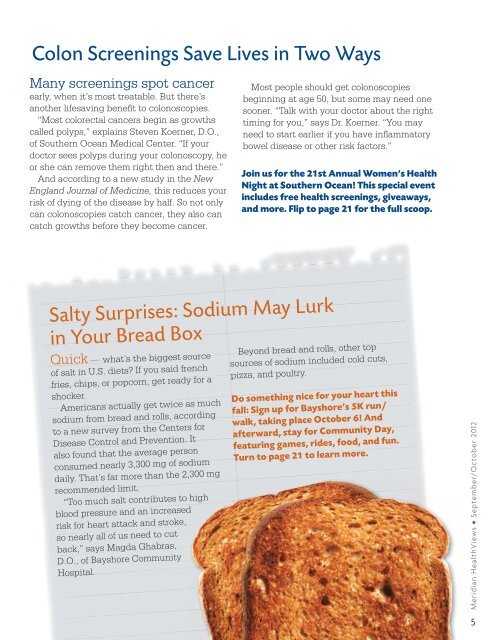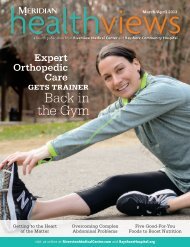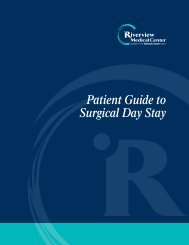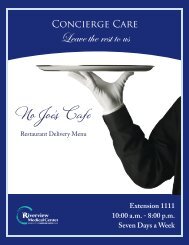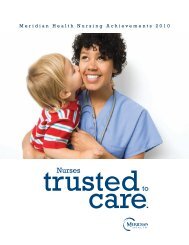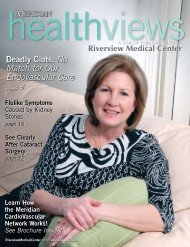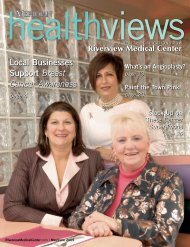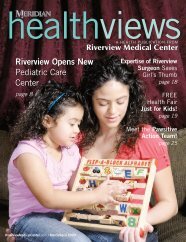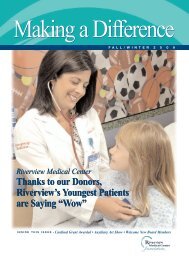Download the September/October 2012 Issue - Bayshore ...
Download the September/October 2012 Issue - Bayshore ...
Download the September/October 2012 Issue - Bayshore ...
Create successful ePaper yourself
Turn your PDF publications into a flip-book with our unique Google optimized e-Paper software.
Colon Screenings Save Lives in Two Ways<br />
Many screenings spot cancer<br />
early, when it’s most treatable. But <strong>the</strong>re’s<br />
ano<strong>the</strong>r lifesaving benefit to colonoscopies.<br />
“Most colorectal cancers begin as growths<br />
called polyps,” explains Steven Koerner, D.O.,<br />
of Sou<strong>the</strong>rn Ocean Medical Center. “If your<br />
doctor sees polyps during your colonoscopy, he<br />
or she can remove <strong>the</strong>m right <strong>the</strong>n and <strong>the</strong>re.”<br />
And according to a new study in <strong>the</strong> New<br />
England Journal of Medicine, this reduces your<br />
risk of dying of <strong>the</strong> disease by half. So not only<br />
can colonoscopies catch cancer, <strong>the</strong>y also can<br />
catch growths before <strong>the</strong>y become cancer.<br />
Most people should get colonoscopies<br />
beginning at age 50, but some may need one<br />
sooner. “Talk with your doctor about <strong>the</strong> right<br />
timing for you,” says Dr. Koerner. “You may<br />
need to start earlier if you have inflammatory<br />
bowel disease or o<strong>the</strong>r risk factors.”<br />
Join us for <strong>the</strong> 21st Annual Women’s Health<br />
Night at Sou<strong>the</strong>rn Ocean! This special event<br />
includes free health screenings, giveaways,<br />
and more. Flip to page 21 for <strong>the</strong> full scoop.<br />
Salty Surprises: Sodium May Lurk<br />
in Your Bread Box<br />
Quick — what’s <strong>the</strong> biggest source<br />
of salt in U.S. diets? If you said french<br />
fries, chips, or popcorn, get ready for a<br />
shocker.<br />
Americans actually get twice as much<br />
sodium from bread and rolls, according<br />
to a new survey from <strong>the</strong> Centers for<br />
Disease Control and Prevention. It<br />
also found that <strong>the</strong> average person<br />
consumed nearly 3,300 mg of sodium<br />
daily. That’s far more than <strong>the</strong> 2,300 mg<br />
recommended limit.<br />
“Too much salt contributes to high<br />
blood pressure and an increased<br />
risk for heart attack and stroke,<br />
so nearly all of us need to cut<br />
back,” says Magda Ghabras,<br />
D.O., of <strong>Bayshore</strong> Community<br />
Hospital.<br />
Beyond bread and rolls, o<strong>the</strong>r top<br />
sources of sodium included cold cuts,<br />
pizza, and poultry.<br />
Do something nice for your heart this<br />
fall: Sign up for <strong>Bayshore</strong>’s 5K run/<br />
walk, taking place <strong>October</strong> 6! And<br />
afterward, stay for Community Day,<br />
featuring games, rides, food, and fun.<br />
Turn to page 21 to learn more.<br />
Meridian HealthViews • <strong>September</strong>/<strong>October</strong> <strong>2012</strong><br />
5


